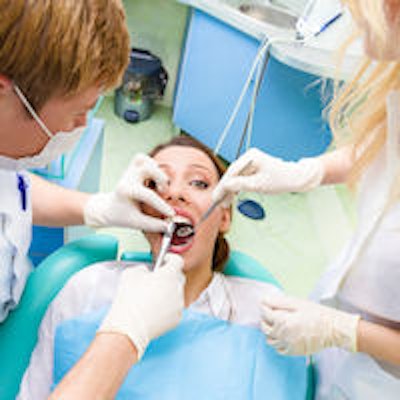
Dental therapists may be able to effectively screen for caries and periodontal disease in low-risk patients, according to a new U.K. study in the Journal of Dental Research. The researchers found that these midlevel providers (MLPs) detected common dental diseases almost as often as dentists.
The study compared the diagnostic test accuracy of dental therapists in the northwest of England to general dental practitioners in the region. Using the dentists' assessments as the reference standard, the researchers evaluated how often MLPs correctly detected caries and periodontal disease in patients who regularly visited their dentist (J Dent Res, March 2015, Vol. 94:3 suppl, pp. 70S -78S).
The therapists correctly identified caries in 81% of patients and periodontal disease in 89% of patients, suggesting that MLPs can be used to screen certain low-risk patients in clinics for these conditions, the researchers found.
The researchers evaluated the role of MLPs in the National Health Service (NHS), the U.K.'s state-funded healthcare system. Therefore, their analysis of the greater good for using dental therapists to evaluate low-risk patients is through the lens of a system in which tax dollars pay for patient care.
Background and methods
Currently, general dental practitioners (GDPs) in the U.K. spend more than two-thirds of their time with patients doing activities related to routine general checkups. However, little research has been done to analyze the effectiveness of dental therapist diagnostics of disease in the general dentistry clinic setting, according to the study authors.
 Richard Macey, research assistant, doctoral candidate, University of Manchester School of Dentistry.
Richard Macey, research assistant, doctoral candidate, University of Manchester School of Dentistry."A large portion of regularly attending adult patients who attend for their checkup do not require any further appointments or active restorative intervention, yet their care is delivered by the most expensive resource, the GDP," wrote lead study author Richard Macey, a research assistant and doctoral candidate at the University of Manchester School of Dentistry, and colleagues.
The study was designed to look at the efficacy of MLPs' disease screening in the general dental clinical setting.
Macey and colleagues conducted their research with 10 clinics that employed at least one dental therapist who provided routine dental care, worked with a large number of U.K.'s National Health Service patients, and had a minimum practice size of three surgeries, among other criteria. All the patients included in the study were part of the NHS, asymptomatic, not experiencing pain, and undergoing a routine checkup.
Before the patient evaluations took place, both the dental therapists and general dental practitioners received a compulsory training, which covered what defined dental caries and periodontal disease for the purpose of the study. Any pre-existing notions held by the dentists or MLPs about disease definitions were to be disregarded for the study.
All the patents were evaluated by both the MLPs and general dentists an average of 21 minutes apart. About half the patients were evaluated by the MLP first, while the other half were screened by the dentists first. Both parties were blind to the other's findings.
Results and the bigger picture
Most of the time the therapists were able to correctly identify patients with caries and periodontal disease with few false positives, the researchers found. Based on the study's findings, for every 100 people who are screened at a dental clinic, a MLP would not detect seven patients with caries and six with periodontal disease.
| Study results | |||
| Patients identified | Dentists | Therapists | Therapist sensitivity/specificity |
| With caries | 668 | 548 | 0.81 sensitivity |
| Without caries | 1,231 | 1,047 | 0.87 specificity |
| With periodontal disease | 1,074 | 953 | 0.89 sensitivity |
| Without periodontal disease | 825 | 621 | 0.75 specificity |
When either disease exists, the dental therapists will correctly classify the patients with a "high certainty," the study authors wrote.
Additionally, the MLPs took about a minute longer on average for each evaluation, and they were more likely to report a false positive to ensure that a borderline patient was screened by a dentist.
The study authors did note that any false negatives are concerning, but they defended the value of dental therapists' evaluations overall. The greater significance is that they correctly identify a caries-free patients 90% of the time, they argued. The authors also noted that "the impact of false negatives would be ameliorated to a large degree, given that the progression of caries is relatively slow in low-risk adult populations."
One problem with the study was using the dentists' evaluations as the reference standard for comparison, according to the authors. However, they noted that alternative solutions, such as using a dental board to define whether each individual patient has caries or not, would be too time-consuming or unethical.
The efficiency of dental clinics in state-funded healthcare systems could improve by better utilizing the whole dental team, the study authors noted. When dental therapists screen for common dental diseases in low-risk patients, it frees up the dentists to focus on patients with a higher need who are not currently getting access to care.
"If unchallenged, this situation where those with the lowest need consume the majority of healthcare resources is likely to exacerbate further and increase oral health inequalities in the United Kingdom," they concluded.



















